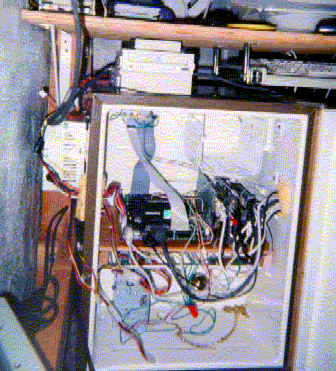
 OVER CLOCKING
OVER CLOCKING WITH A FREEZER
Disclaimer: I wont be held responsible for damage done to your computer, cpu, computer hardware, freezer, refrigerator, etc should you decide to replicate anything on this page. If you do decide to replicate something on this page you do so at your own risk, and must be willing to suffer all consequences whether you feel they are fair or not. Look, it took a sub-moronic IQ to do this experiment in the first place so don't even attempt it even if you really know what you are doing.
Last summer I mustered some money together and bought two fridges for the fist part of an over clocking experiment. I wanted to test the theory promoted by several people on the internet that this method of cooling will cause damage to my computer due to condensation. I would like to make a couple of things clear. This experiment was just that, an experiment. I don't advocate people putting their computer in freezers as a permanent way of over clocking. As a matter of fact, I don't advocate over clocking at all. Every body knows that the best computer is the one that runs fast at room temperature. It is just really really cool to stretch the limits by doing experiments like these every once in a while.
I got one fridge for free and the other cost me $30. I bought them from senior at a local college who did not want to take them home. Each refrigerator was more than capable of freezing water. I unfortunately was not able to over clock due to a limitation in money. I could not afford a new motherboard that can support a speed in excess of my processor. But this experiment should prove that this is a possible way to over clock and that water vapor in a freezer is not a problem. I look forward to seeing extensions on this experiment in the future.
Here is what it looked like when it was done.

I mounted the power supply, cdroms, and 3.5 inch on the outside of the refrigerator. My reasoning on this was to not add any heat unless absolutely necessary. Also, by putting them on the outside I lessened the chance of damaging components if condensation occurred. In order to do that I needed to cut three holes in the wall of the refrigerator. I then took sponges, put several coats of lacquer on them in order to minimize heat and water exchange from outside the fridge. Holes were cut in the middle of sponges and the wires were inserted through. Then the sponges were stuffed into the holes in the fridge. Static electricity increases as temperature and humidity decreases so an antistatic chain was installed by drilling a hole in the base of the fridge. The chain was then attached to the motherboard and hard drive.
The next problem that needed to be tackled was the water condensation issue. Water condensation increases as temperature decreases. I used desiccant made by taking Epson salt and baking it in the oven for several days1 until all the water was out. I then put the desiccant in trays and put them on every available spot possible in the fridge. I looked for a humidity measuring device with a probe and could not find one. It would have been nice to quantify the drop in humidity. As it was the drop in humidity was noticeable to the eye. After several test runs in the second refrigerator that I bought, I felt that it was safe to do a real run.
As stated before, I was unable to over clock and test the extents to which this will work. The most valuable part of this experiment was to show that the use of this desiccant is a viable way of controlling the humidity for short periods of time. After allowing the desiccant to sit in the fridge for about 6 hours, I turned on the fridge to the lowest setting. After about 3 hours after the fridge was turned on I turned on my computer. The computer ran without problems for 2 days with the fridge on. An internal fridge temperature of -15 degrees centigrade was maintained for the duration of the test. Slight condensation did occur on the site of the cooling unit in the upper right hand side of the fridge. No other sites of noticeable condensation were found.
CONCLUSIONS:
This desiccant is a viable way of controlling the condensation problem involved with using refrigerators. However, long term use may and probably will pose more problems. There must be an upper limit as to the amount of time the desiccant will last before it needs to be replaced. I have heard of a cheap alternative to dehydrated Epson salt and hope to start a new experiment with it. There is a good possibility that this other desiccant could lower the humidity even more. I will keep you posted. Oh one other note that affects this experiment. I live in a desert area, that is pretty dry to begin with.
Note: The majority of the money made will go to helping people with autism. If I have money left over, then it will go to my over clocking experiments. Sorry but this little boy needs my help now, not in a year or so.
for suggestions or question or if you just want to tell me where I screwed up email me